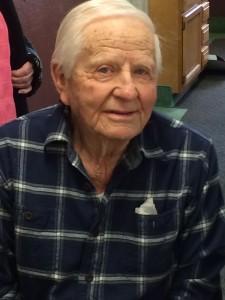
On February 24, 1924, at the Ideal, SD home of Charles and Dora (Bainbridge) Heller a baby boy was born. They named him Lowdon (a family sir name). Lowdon was the fifth child and had three sisters and four brothers.
At age four he started school at East Star Valley. Lowdon and his siblings walked four miles to the one room schoolhouse. A small chap, he would sit on the teacher’s lap so that he could see the chalkboard. Lowdon continued his schooling in Ideal where he excelled in journalism and public speaking. He was in the choir, played piano, and could dribble a mean basketball. Lowdon graduated from Ideal High School in 1941.
Lowdon entered SDSU at Brookings and was there when World War II broke out. He enlisted in the Army Air Corp in 1944. Lowdon learn how to fly his father’s Aronka airplane as did siblings Wayne, Kenneth, Alva, and Melba. Flying proved to be very useful when he served as a gunner on a B24 bomber in the European Theater and was awarded the Air Medal. His buddies nicknamed him “Whitey” because of his very blonde hair. When World War II ended he used the GI Bill to get a degree. Lowdon began his teaching career in Winner and Witten. He was the principal at Spring Creek. He continued teaching in Kyle and Lead/Deadwood. While teaching he continued to own and operate the Shannon County News and direct at the Black Hills Playhouse.
In 1957 Lowdon was elected to the South Dakota State Legislature. He proudly served on the transportation committee introducing laws concerning roads and the state airplane. During his political career Lowdon was a delegate to the Presidential Convention in Miami supporting his close personal friend George McGovern.
Lowdon then took a job as head of the juvenile correction facility in Plankinton.
He returned to his beloved Tripp County. Lowdon was a true “jack of all trades” and “wore many hats” –sometimes three at a time and he wore them well. Real estate broker, insurance agent, and professional collector were some hats he wore. His heart was on the farm with his buffalo, cows, sheep, goats, geese, chickens, and horses. Pheasants, coyotes, and prairie dogs visited often. At age 90 he chopped ice and ventured out in the snow so his animals would have food and water. He planted his crops and was often seen riding his Moline tractor. The last few years he hired the farming done. Lowdon grew a big garden and was always experimenting with new seeds. He planted over 500 trees and grafted many hoping to discover a “perfect apple tree.” His latest project was developing “white angus” so they wouldn’t overheat. Lowdon and brother Wayne worked side by side on the farm for many years. Wayne passed away in 2012 and Lowdon continued to live and work on his home place.
He was a busy, hardworking man who made time for his friends and his activities. Lowdon played Santa to the community children and hosted pheasant, deer, and prairie dog hunters. Many fishermen enjoyed catching bass in his dam and visiting with Lowdon.
Although he didn’t always have reliable transportation, he enjoyed traveling. His travels took him to Canada, Alaska, Wyoming, and Washington DC for the Veteran’s Honor Flight. His niece in Florida looked forward to his visits and his last visit extended six months.
Lowdon enjoyed the auction. He hauled his “treasures” in one of the many cars he bought. “Never know when I need a spare car part” he would say.
Tripp County Rockhounds, weed board, township board, VFW, American Legion, Sunday School Secretary, Tripp County and South Dakota Historical Society, and Tripp County Democrats were part of his life.
He enjoyed mentoring youth and was very respected by the village youth. Elders referred to him as “Brother.”
Lowdon was a “Brother” to many near and far. This was evident by the many people who would stop by to visit him, leaving with a history lesson about Lowdon’s philosophy of life.
Lowdon was a true survivor and always had a plan B. Even when his home burned down, he had a plan to move to the Ideal School that had been remodeled. While in Florida, a tornado blew the roof off the schoolhouse. After losing two homes in less than a year, Lowdon moved to Elder Inn. Friends would take him out to check on his cows and to look over the country. He stayed in contact with family and friends via e-mail, telephone, and letters. Lowdon was very happy at Elder Inn.
Respecting the “Duty, Honor, Country” motto and wanting to recognize fellow veterans for their service and sacrifice, Lowdon was a driving force in building the Veteran’s Wall at the Winner Courthouse. He wrote the program structure that is used at Winner Memorial Day Programs and was instrumental in the development of the Avenue of Flags at the Winner Cemetery.
